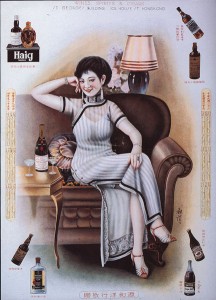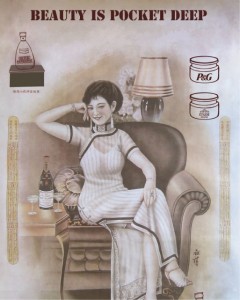Introduction to the Cosmetics Market in China:
My article, “In China’s Cosmetics Market Beauty is Pocket Deep”, commented on the dynamic nature of the cosmetics market in China today by assessing the extent of success both Western and Eastern cosmetics companies are currently having in the market. The author, Jill Petzinger, highlighted how Western cosmetic companies are finding it hard to keep with the ever changing tastes of local Chinese customers. Local Chinese companies can accredit the current trend of using traditional Chinese ingredients in products to their recent successes in the market, a strategy Western companies are just now starting to use.
What I found interesting is that the image Petzinger chose to be the main focus of her article was in fact an image we had seen before in earlier units of the class- a 1934 liquor advertisement from Grand, Price & Co. Petzinger simply replaced some of the wine bottles with current beauty products. I found myself very intrigued by why she chose to transform this advertisement into something completely different- an advertisement that I wouldn’t have thought to relate to the cosmetics industry at all. What could this ad have to do with the current status of the cosmetic market in China? For this reasons, I am choosing to highlight and compare the two images in my wordpress project this week, and draw a connection between the ad’s relevancy then and now in China’s economy. very nice introduction

From: Lao Shanghai Guanggao (Advertisements of Old-time Shanghai) Yi bin, et al. (Shanghai: shanghai huabao chubanshe, 1995)
page 90
Liquor advertisement from about 1934

Advertisement Remade for the article: “In China’s Cosmetics Market, Beauty is Pocket Deep”
Contrasting the Images: Connotation and Dennotation
The first immediate difference I noticed between the two was the substitution of alcohol, the primary advertisement, for cosmetics commodities, such as Procter and Gamble cosmetics. This completely rebuilds the objective of the advertisement, yet at the forefront of the picture, we are still greeted with the highly sexualized woman dressed in qipao. Much like she was inviting us to come and drink wine with her in the first ad, the remade ad still possesses these invitational qualities. Clearly, she is using cosmetics in the image. She looks very beautiful and done up, as if to say if you use these cosmetics, you can be as beautiful as her. The slit up her leg gives the ad an air of promiscuity, and her dress is almost see through. Why did the makers of the ad sexualize the woman in the qipao in the first place? They wanted the outsider to consume this image: to want her or to want to be her. By sexualizing her they were promoting the product. more detailed analysis: how is the substitution made and for what purpose
Relation to the Cosmetics Industry Today
All of this made me think: What does this have to do with products today, especially that of China’s cosmetics market. Through not only my presentation, but those of my peers, I have seen that the use and popular market for cosmetics in China has projected the idea of an ideal woman. And relating back to my article, which noted the high popularity of the cosmetics marked today in China, we can observe that this sexualization of consumerism subsists from the past to today. The woman projected at the forefront of these two pictures is the ideal Chinese woman. Through the use of both the wine, and current cosmetic products, you can be just like her.
